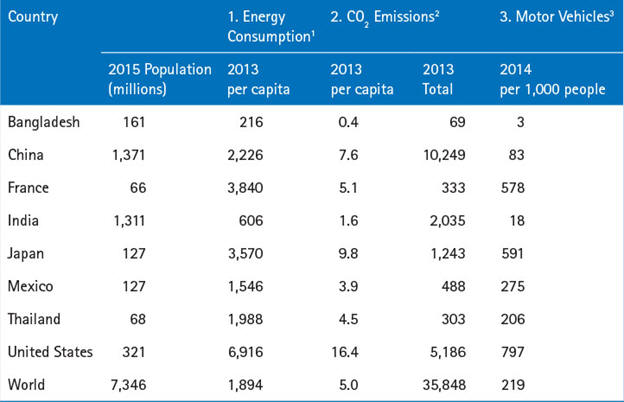|
F. Sustainable Development
.
1. Economics of sustainable development
a. Multiple dimensions
.
.
.
.
.
.
.
.
.
(1) Environmental resilience
.
(2) Social equity
.
(3) Economic sufficiency
.
b. Implications for developed and
developing countries

.
(1) Developed countries
-
Large capital stocks and extensive
infrastructure - power plants, highways, factories, urban and
suburban business and residential construction, dams, irrigation
systems, etc.
-
More possible and affordable to put
environmental protection systems in place
-
Technological and
social lock-in - dependence on a particular technology or
accepted system of production and consumption
.
(2) Developing countries
-
Major social and economic goal is to
increase production to raise incomes
-
Also have considerable population growth
momentum
-
Projects to increased resource use and
increased waste and pollution
-
Greater choice as to development path to
follow
-
Have access to improved technology and
knowledge of errors made
-
Must compete with developed countries for
resources
.
2. Reforming global institutions
a. International economic institutions
(1) International Monetary Fund (IMF) -
focus on exchange rate stability and eliminating exchange restrictions
that hinder trade
.
(2) World Bank - provides loans, sometimes
at reduced interest rates, to developing countries to reduce poverty and
support development
-
Supports projects in education, health,
public administration, infrastructure, financial and private sector
development, agriculture, environmental and natural resource
management
-
Some consideration to environmental issues,
but development goals typically take priority
-
Loans need to be repaid => emphasis on
export promotion, which could lead to exploitation of natural assets
.
(3) World Trade Organization (WTO) -
regulates international trade, tries to lower trade barriers
Ex. - Genetically modified beef
.
b. Millennium Development Goals (U.N.,
2000)
(1) Eradicate extreme poverty and hunger
-
Goal - Halve proportion of people living on
less than $1.25 a day; halve the proportion of people who suffer
from hunger
-
Result - Poverty achieved, hunger narrowly
missed
.
(2) Achieve universal primary education
-
Goal - All children, both boys and girls,
complete primary education
-
Result - Enrollment went from 83 percent to
91 percent
.
(3) Promote gender equality and empower
women
.
(4) Reduce child mortality
.
(5) Improve maternal health
.
(6) Combat HIV/AIDS, malaria, and other
diseases
-
Goal - Halt and reverse spread of HIV/AIDS,
malaria, and other diseases
-
Result - HIV infections fell by 40%, but
overall target not met
.
(7) Ensure environmental sustainability
-
Goal -
Integrate the principles of sustainable development into country
policies and programs; reverse loss of environmental resources;
reduce biodiversity loss, halve the proportion of the population
without sustainable access to safe drinking water and basic
sanitation
-
Result - Water goal met, sanitation not
.
(8) Develop a global partnership for
development
.
c. Sustainable Development Goals
(1) Ensure sustainable consumption and
production patterns
(2) Take urgent action to combat climate
change and its impacts
(3) Conserve and sustainably use oceans,
seas, and marine resources for sustainable development
(4) Protect, restore, and promote
sustainable use of terrestial ecosystems, sustainably manage forests,
combat deforestation, halt and reverse land degradation, halt
biodiversity loss
.
d. Sustainability issues and urban areas
-
80 percent of world's population will live
in cities by 2050
-
3 percent of land, but 50 percent of waste,
60 - 80 percent of greenhouse gas emissions, 75 percent consumption
of natural resources
-
Issues include sustainability practices in
transportation, housing, waste disposal and recycling, energy
efficiency, and water management
.
3. New goals and new production methods
a. Agriculture
-
Expanding population and expanding
consumption per capita puts strain on soil and water
-
Shift from current situation to organic soil
rebuilding, integrated pest management, and efficient irrigation
-
Need to limit population growth and have
greater food distribution equity and efficiency
-
Dietary changes might be required
.
b. Industry
.
c. Energy
-
Due to supply limits and environmental
impacts, transition away from fossil fuels
-
Less centralized, adapted to local
conditions, high energy efficiency, utilize solar, wind, and
sustainable biomass
.
d. Renewable resource systems
-
Fisheries, forests, and water systems
already overstressed
-
Growing population will lead to increased
demand
-
Shift from exploitation to conservation and
sustainable harvesting
.
e. Water resources
-
Water scarcity will be a critical factor in
many parts of the world
-
Made worse by climate change
-
Need increased water efficiency and
recycling, reduced water pollution, and extended water and
sanitation access to low-income communities
.
4. Redefinition of development
=> natural capital should be maintained
.
=> loss or degradation of natural capital can be
made up for by accumulation of manufactured capital
.
.
.
.
.
.
.
.
.
.
-
Requires constraints on material consumption
-
Some activities require little or no
resource consumption - services, arts, communication, education
-
Could have more leisure as opposed to
material consumption
-
Post-growth
economy - economy has completed the process of economic
growth and operates with no further increase in resource and energy
use (possibly a decrease)
-
Doesn't have to result in decreases in
employment
| Country |
Total Clean Energy Jobs Created
through Investing 1.5% of GDP |
Net Clean Energy Jobs Created after
Subtracting Fossil Fuel Job Losses |
| Brazil |
925,000 |
395,000 |
| China |
11.4 million |
6.4 million |
| India |
12 million |
5.7 million |
| Indonesia |
954,000 |
752,000 |
| U.S. |
1.5 million |
650,000 |
.
5. Policy proposals
a. Green taxes
-
Pigouvian tax on negative externalities -
fossil fuel use, resource extraction, pollution generation
-
Can make the policy revenue neutral by
cutting other taxes (income, payroll, corporate, capital gains)
.
b. Elimination of agricultural and energy
subsidies
-
Currently encourages overuse of energy,
fertilizer, pesticides, water
-
Promote nutrient recycling, crop
diversification, natural pest controls
.
c. Greater recycling of materials and use
of renewable energy
.
d. Efficient transportation systems
-
Replace automotive transport with high-speed
trains, public transit, increased bicycle use, redesign of cities to
minimize transportation needs
-
Use fuel efficient cars in countries that
already have large auto infrastructure
.
e. Accelerated development of renewable
energy systems
-
Solar, hydroelectric, wind, geothermal, fuel
cells, high-efficiency industrial systems
-
Can redirect current subsides from fossil
fuels to alternative energy sources
|


